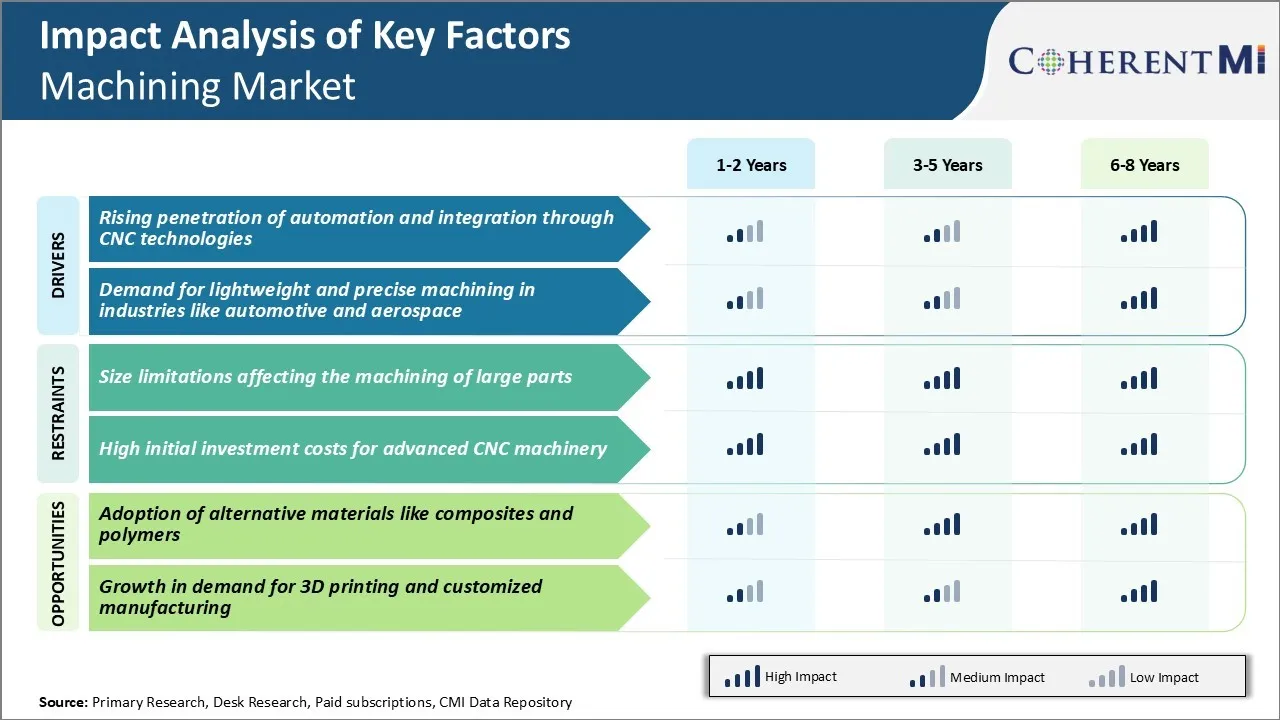機械加工市場 サイズ - 分析
市場規模(米ドル) Bn
CAGR6.5%
| 調査期間 | 2024 - 2031 |
| 推定の基準年 | 2023 |
| CAGR | 6.5% |
| 市場集中度 | High |
| 主要プレーヤー | ファナック株式会社, DMG森精機株式会社, 株式会社アマダ, アトラスコプコAB。, BystronicレーザーAG。 その他 |
お知らせください!
機械加工市場 トレンド
市場ドライバ - 自動車や航空宇宙などの産業における軽量で精密な加工の要求
業界全体の軽量設計に重点を置いたライジングは、高度な加工技術のための重要なドライバーです。 自動車空間では、自動車OEMおよびサプライヤーは、新材料選定と最適化されたコンポーネントエンジニアリングによる平均15〜20%の軽量化を追求しています。
エアロスペースは、加工能力をプッシュする別のヘビー級産業です。 飛行機メーカーは、ジェットエンジンやエアフレームのスーパーエンジニアリング合金と一緒に、カーボンファイバーなどのコンポジットを活用しています。 これらは、現代のエキゾチックな金属やコンポジットを最大限の精度で加工できる革新的な加工ソリューションを必要とします。 設計仕様からの逸脱でも、安全を防いでいただけます。
元の機器メーカー(OEM)と規制当局が厳しい締め切りを指摘し、機械加工市場は、ダイ(SMED)の1分の交換のようなリーン製造システムを急速に展開しています。 複数のプロセスを組み合わせるスマートな機械アプリケーションのためのこの呼び出しは、プラグアンドプロデュースクイックチェンジオーバー。 これらすべてのニーズは、機械ベンダーからの技術革新を燃料化し、この戦略的産業における継続的な成長見通しを運転しています。

市場機会 - 複合材料やポリマーなどの代替材料の採用
加工市場にとって重要な機会は、高度な複合材料およびポリマー材料の採用の増加にあります。 軽量化はエネルギー効率および性能を改善することを目指している多くの企業セクターを渡る衝動になりました。 複合材料は、金属合金よりも同等の強度から重量比を上げる一方で、設計の創造的な自由を可能にします。 航空宇宙、自動車、船舶、再生可能エネルギー製品に採用が進んでいます。
繊維強化プラスチックとエンジニアリング熱可塑性の加工は、金属と比較して異なる課題を貫くだけでなく、市場を拡大する。 コンポジット製造が成長するにつれて、コンポジットコンポーネントの加工の必要性が大幅に上昇します。 特殊加工センターは、研磨水ジェット切断や高圧液ジェット侵食などの技術を用いてこれらの材料を扱うことができる開発されています。
層1サプライヤーからの高度なポリマー複合材の可用性は、加工の見通しも向上します。 代替材料のゲイン受容性として、加工市場は、関連する技術とプロセスを開発し、この傾向を増大する機会を持っています。
主要プレーヤーが採用した主な勝利戦略 機械加工市場
先端製造技術への投資: DMG Mori、Haas Automation、Doosan Machineなどの企業 ツールは、CNC機械、コンピュータ加工(CAM)ソフトウェア、および生産性と品質を向上させるための添加剤製造などの高度な技術に大きく投資しています。
カスタマイズされたソリューションに焦点を当てる: HardingeやJinan North Machinery Co.などのプレイヤーは、マシンを販売するだけでなく、顧客にカスタマイズされた柔軟な加工ソリューションを提供することに焦点を当てています。 適切な機械、工具細工、自動化、統合に関する顧客のプロセスや提案を理解しています。
戦略的買収: マシニング企業が他のプレイヤーを買収し、グローバルに展開しています。 たとえば、2021年にHurcoはインドのCNCルーターメーカーAkhuria CNCを買収し、インドの生産拠点を設立しました。 これにより、Hurco は成長するインド市場を直接提供するようになりました。
アフターマーケット営業とサービスに焦点を合わせる:小松や奥沼などの加工市場での主要選手が、アフターマーケットの売上の50%以上を稼いでいます。
セグメント分析 機械加工市場

洞察、エンド使用による:自動車適用は大規模な機械化の容積と支配します
自動車産業は2024年に機械加工市場の40.2%のシェアを占めます。 これは、単一の車両で数千のコンポーネント部品を生成するために必要な巨大な加工量によるものです。 自動車加工の需要を燃料とする主要なドライバーは、毎年10億台に測定された自動車生産の規模です。 このような大規模な出力レベルを実現するため、超効率的な加工技術と生産システムが搭載され、高耐容性とボリュームで自動車部品をめぐり合わせることができます。
また、自動車製造プロセスの複雑さとカスタマイズニーズは、加工の柔軟性に優れています。 この高度に統合されたアプローチは、現代の自動車製造を定義する正式な生産方法とビルド・ツー・オーダーの大量生産モデルを達成するために不可欠です。
自動車環境内の密接で洗練された加工作業負荷を集中するこれらの要因の混乱は、世界的な加工技術のための最大のエンドユーザー産業としての地位を隠しました。
追加の洞察 機械加工市場
- 産業オートメーションのCNC機械の上昇の使用は機械化の市場の成長を後押しします。
- 精密な部品製造の要求によるCNC旋盤機械の成長は機械化の市場の上昇傾向です。
- アジア・パシフィックは、費用対効果の高い操作と原材料の可用性により、加工市場を支配します。 しかし、欧州はドイツ、フランス、イタリアが主導し、著しく成長する予定です。
競合の概要 機械加工市場
マシニング市場で動作する主要な選手は、株式会社ファンック、DMG MORI、株式会社アマダ、アトラスコプコAB、Bystronic Laser AG、TRUMPF GmbH、株式会社オクマ、サンドビックAB、ヤマザキマザック、IPGフォトニクス株式会社などがあります。
機械加工市場 リーダー
- ファナック株式会社
- DMG森精機株式会社
- 株式会社アマダ
- アトラスコプコAB。
- BystronicレーザーAG。
機械加工市場 - 競合関係

機械加工市場
(大手プレーヤーが支配)
(多くのプレーヤーが参入し、競争が激しい。)
最近の動向 機械加工市場
- 2023年2月、雇用主とCNCの町家をつなぐ専門職のHireCNCが誕生しました。 プラットフォームは、米国およびカナダ市場でのCNC関連ジョブに焦点を当て、CNC加工業界の求職者と雇用者の両方の雇用プロセスを合理化することを目指しています。
- 2023年1月、三菱電機インドのCNC事業部が「Teach-T」を導入し、学生のCNC技術教育を強化 この取り組みは、政府の入札やプロジェクト、ITIs、卒業証書コース、民間工学のトレーニングセンターなど、教育分野に参入するための企業戦略と整合しています。
- 三菱電機インディアは、製造の効率化と技術革新を目指し、CNCのM800VとM80Vシリーズを導入しました。 これらのCNCは、業界初のビルトイン無線LANを備え、リモートアクセスと制御を可能にし、ポストパンデミック時代に特に有益です。
機械加工市場 セグメンテーション
- タイプ別
- 旋盤機械
- レーザー加工機
- フライス盤
- 粉砕機
- ウィンド マシーン
- 溶接機
- エンド使用
- 自動車産業
- 航空宇宙・防衛
- 建設機械
- 電力とエネルギー
- 産業

購入オプションを検討しますか?このレポートの個々のセクション?
Ramprasad Bhute は、市場調査とビジネスコンサルティングで 6 年以上の経験を持つシニアリサーチコンサルタントです。建設工学と産業オートメーションおよび機械を専門とするこの専門家は、プロセスの最適化と運用効率の向上に特化した強力なスキルセットを開発しました。注目すべき業績には、大幅なコスト削減と生産性の向上をもたらした重要なプロジェクトを主導したことなどがあります。たとえば、彼は大手建設会社の機械プロセスの自動化で重要な役割を果たし、運用効率を 25% 向上させました。複雑なデータを分析し、実用的な洞察を提供する能力により、彼はこの分野で信頼できるアドバイザーとなっています。
よくある質問 :
加工市場はどれくらいの大きさですか?
加工市場は2024年のUSD 402.56 Bnで評価され、2031までにUSD 625.55 Bnに達すると予想されます。
加工市場の成長を妨げる重要な要因は何ですか?
高度なCNC機械のための大きな部品と高い初期投資コストの加工に影響を与えるサイズの制限は、加工市場の成長を妨げる主要な要因です。
加工市場の成長を牽引する主要な要因は何ですか?
CNC技術による自動化と統合の普及と自動車や航空宇宙などの産業における軽量かつ精密な加工の要求は、加工市場を牽引する主要な要因です。
加工市場でのリーディングタイプは?
主要なタイプ区分は旋盤機械です。
加工市場で活躍している主要な選手は?
株式会社ファンヌック、株式会社DMG森、株式会社アマダ、アトラスコプコAB、Bystronic Laser AG、TRUMPF GmbH Co.、株式会社オクマ、サンドビックAB、山崎マザック、IPGフォトニクスは、主要な選手です。
加工市場のCATGとは?
加工市場のCAGRは、2024-2031から6.5%となるように計画されています。